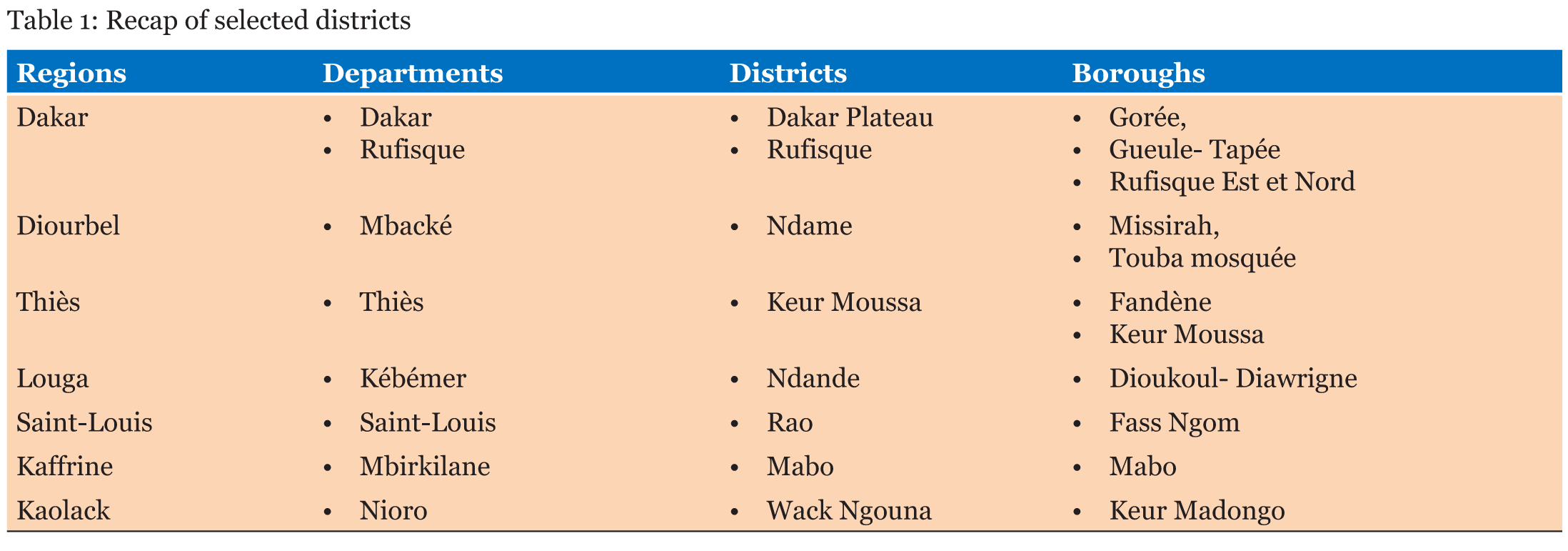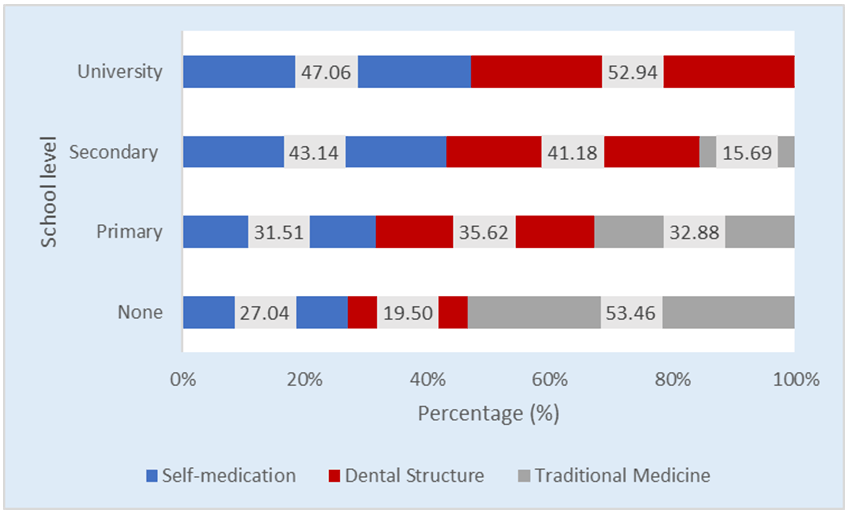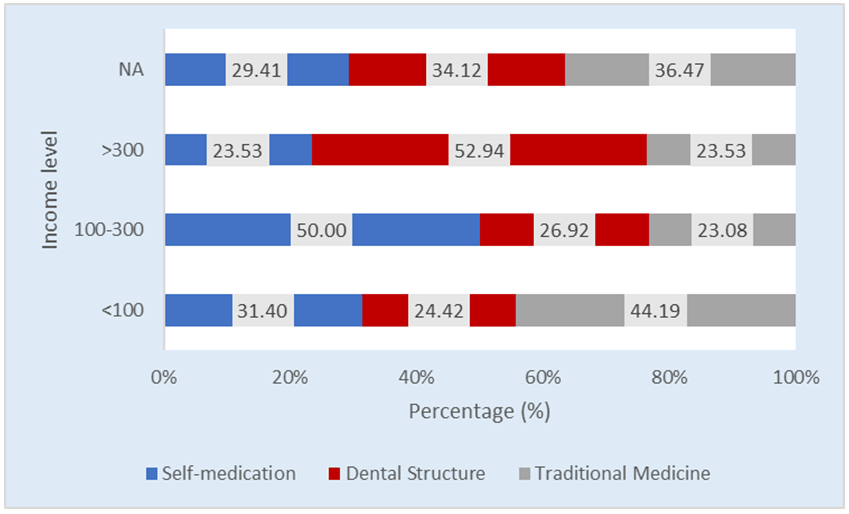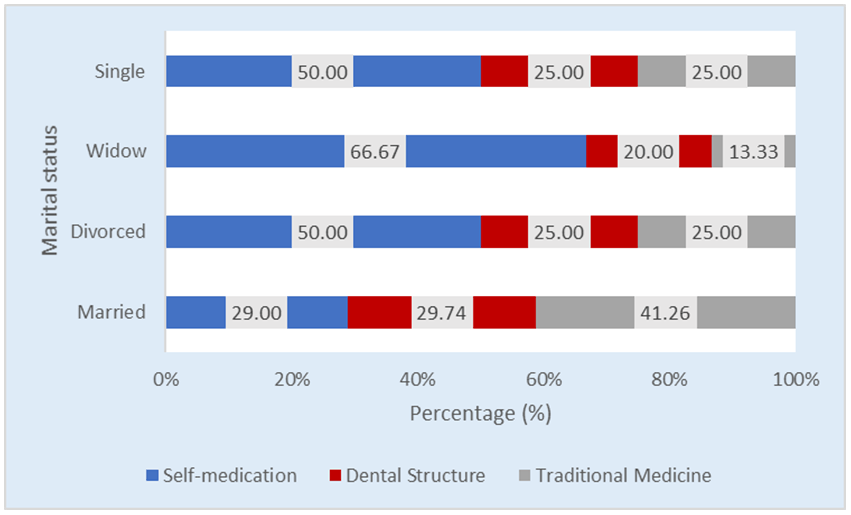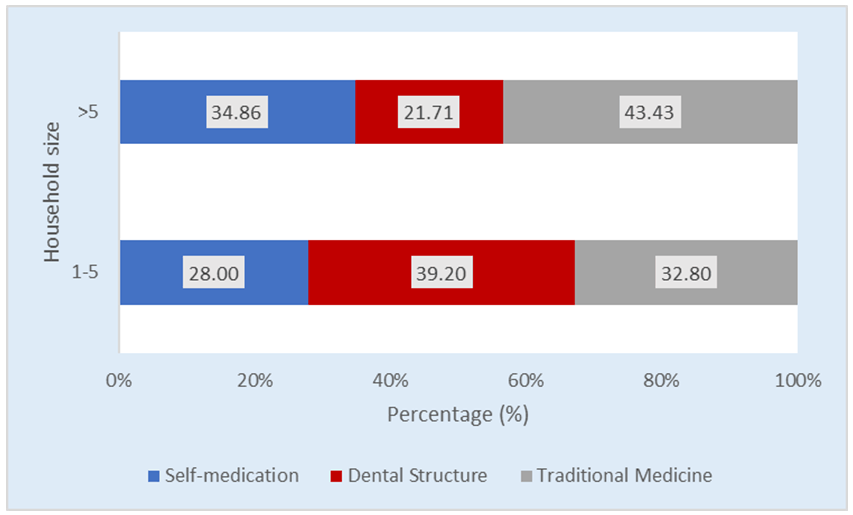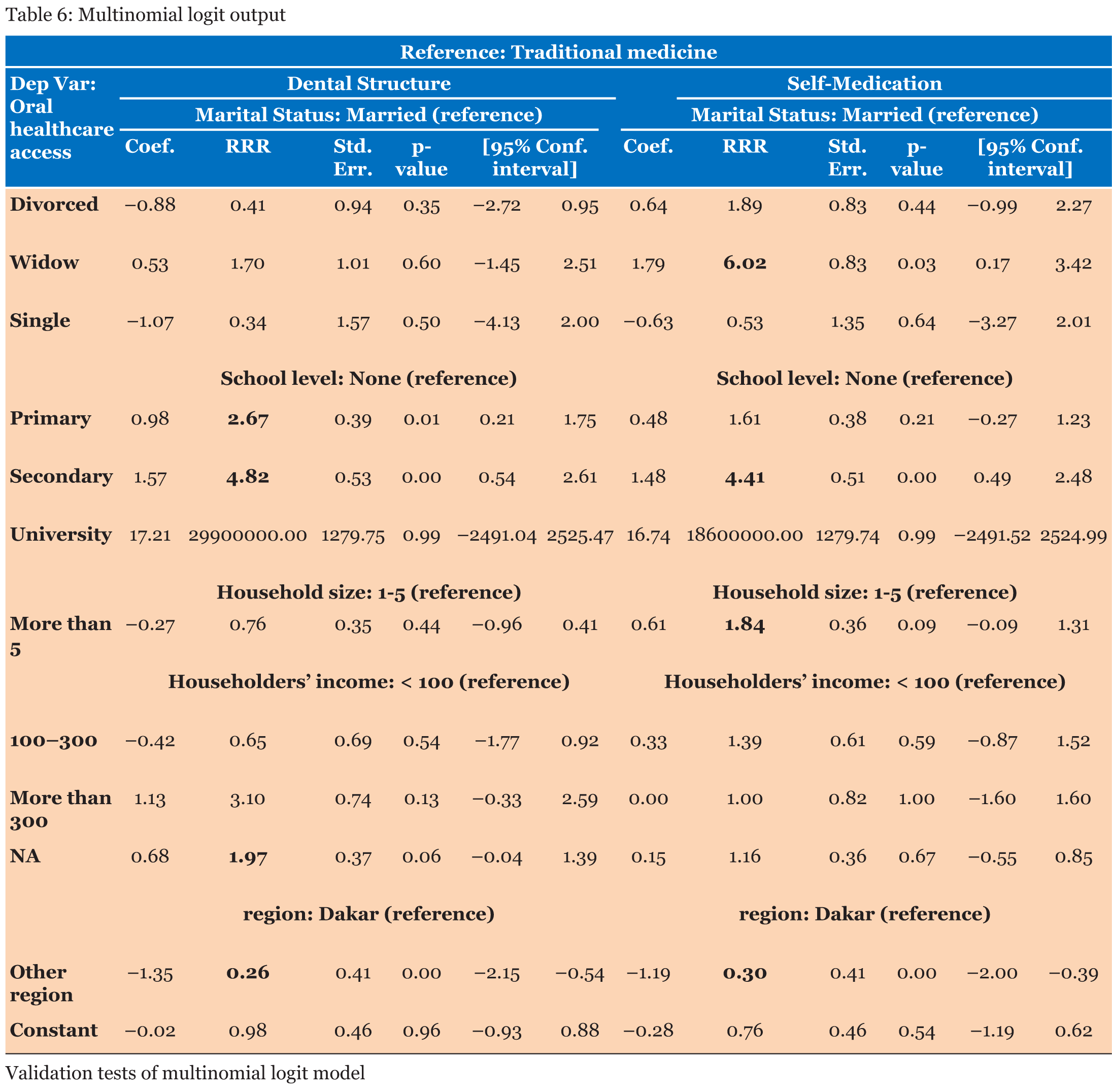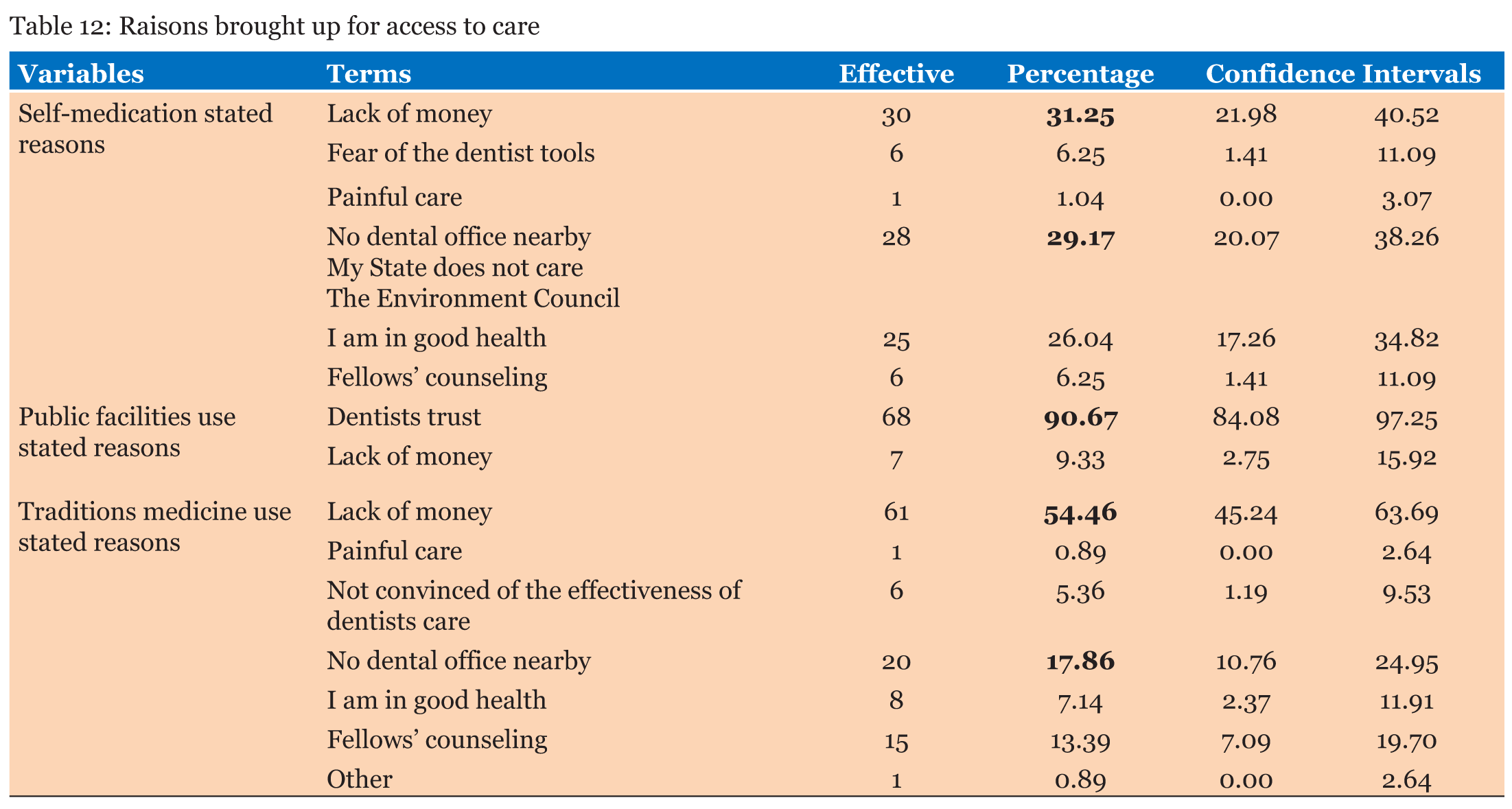 |
|
Original Article
| ||||||
| Behavior of the access to oral health care in Senegal | ||||||
| Mbathio Diop1, Aida Kanouté1, Massamba Diouf2, Amadou Diaw Ndiaye3, Cheikh Mouhamadou Mbacké Lo4, Daouda Faye4, Daouda Cissé4 | ||||||
|
1Assistant, Department of Public Health Faculty of Medicine, University Cheikh Anta Diop of Dakar, Senegal
2Assistant Professor, Department of Public Health Faculty of Medicine, University Cheikh Anta Diop of Dakar, Senegal 3Doctor, Department of Public Health Faculty of Medicine, University Cheikh Anta Diop of Dakar, Senegal 4Professor, Department of Public Health Faculty of Medicine, University Cheikh Anta Diop of Dakar, Senegal | ||||||
| ||||||
|
[HTML Abstract]
[PDF Full Text]
[Print This Article]
[Similar article in Pumed] [Similar article in Google Scholar] |
| How to cite this article |
| Diop M, Kanouté A, Diouf M, Ndiaye AD, Lo CMM, Faye D, Cissé D. Behavior of the access to oral health care in Senegal. Edorium J Public Health 2017;4:58–68. |
|
ABSTRACT
|
|
Aims:
Oral diseases, due to their high frequency and huge impact on overall health and quality of life, and which is reflected on the wellbeing, qualify as a public health issue. In Senegal, the poor condition of dental health is often associated with the socioeconomic situation. The aim of this work is to analyze the behavior of the access to dental care of Senegalese.
| |
|
Keywords:
Access, Mutual, Oral care, Senegal
| |
|
INTRODUCTION
| ||||||
|
Access to healthcare is a basic human right. The government is responsible for guaranteeing to the population a quality healthcare. Indeed, oral health is part of individuals’ health and a determining factor of quality of life. However, oral diseases such as dental caries and periodontal diseases are a real public health issue, especially in developing countries [1]. In addition, oral health, which is a priority most deprived ones have to deal with, is less considered compared to general pathologies. Fortunately, the globalization is improving people’s living conditions in developing countries where the high consumption of sugar [2] results in an incessant increase of dental caries occurrence. Yet, access to oral health services is limited; these days, the majority of the population in more than 150 countries lack access to dental care [2]. In Senegal, the number of dentists per inhabitant is about one per 27,591 or the ratio of one dentist per 10,000 inhabitants, as recommended by the WHO. It is, however, necessary to point out the blatant discrimination in the access to oral care because, on top of staff shortage; dentists are disproportionately assigned across the territory, with 74% of them practicing in the region of Dakar [3]. In addition to that, oral diseases are among worldwide costly diseases to treat for and a great part of the population gives up on oral health care. In short, the high concentration of care offered in urban areas and the high cost of provided services are to blame for the lack of access to care. Moreover, the demand for care is high in a country with reduced number of practitioners; such fact highlights householders’ access issue to oral care, especially the deprived ones, leaving them to the mercy of perilous practices for care. Faced with this situation, incorporating an overall oral health care coverage through health insurance is imperative. The expansion of mutual structures, in the context of UHC, is an opportunity to improve the Senegalese population’s oral health. Thus, a study on the access to oral health care will put forward its intrinsic hurdles so that policy-makers can appropriately decide for the entire population. To achieve this aim, an epidemiological cross-sectional and descriptive survey, based on direct questioning, was carried out on a sample of the Senegalese population. | ||||||
|
MATERIALS AND METHODS
| ||||||
|
The data was collected from 28 April 2016 to 28 May 2016 through direct questioning. | ||||||
| Type of study | ||||||
|
A cross-sectional and descriptive epidemiological survey was carried out. | ||||||
| Targeted population | ||||||
|
Senegalese residing in selected localities and who agreed to take part in the study were targeted. | ||||||
| Selection criteria | ||||||
|
The sample selection criteria are to:
| ||||||
| Sampling | ||||||
|
The adopted sampling procedure is that of the WHO, described in its basic methods. Indeed, WHO’s recommendations suggest the choice of twelve sites nationwide; four from the capital, four from two major regions and four from rural areas [4]. In other words, it consisted of surveying 100 households in the capital (Dakar), 100 in two economically important regions (Thiès and Diourbel) with respectively 50 households each, and 100 households in four other randomly selected regions. The study focused on health insurance. Therefore, the choice of the four sites was based on the Decentralization and Extension of Coverage of Health Insurance’s project (DECHI) [5]. Thus, the regions of Saint-Louis, Louga, Kaolack and Kaffrine were selected. One department per region (except for Dakar where 2 departments were selected) with districts and boroughs, were randomly selected (Table 1). In each borough, from house to house, the person in charge of the family’s medical care is interviewed. In the absence of the householder, the spouse is interviewed. In the case of districts with several neighborhoods (Gueule Tapée - Fass - Colobane), one neighborhood is randomly selected. | ||||||
| Tools (variables and indicators) | ||||||
|
The information gathered to study the access to oral care refers to socio-professional group, regular visits to the dentist, type of cure and the above mentioned reasons. | ||||||
| Data collection | ||||||
|
Two dental surgeon students and a statistician were used to conduct the survey. After a two days’ training, to assess the questionnaire’s feasibility, a preliminary test was performed on 10 households in Colobane, Dakar region. At the end, some questions, such as what to do in the case of the householder’s absence needed to be altered. After the survey, the interviewed family got educated in oral hygiene. | ||||||
| Data analysis | ||||||
|
At the end of the survey, the data collected was processed with CS Pro software version 6.3. The R software was used for graphical representation and the SPSS software to format tables and draw charts. | ||||||
| Socio-demographical characteristics of householders | ||||||
|
In all, 300 householders had participated in the study with 57% women and 43% men. Householders were on average 45-year-old with a standard deviation of 15 years. In addition, it was noted that 58.30% of surveyed households had more than six members. When it comes to school level and professional occupation, the study showed that more than half of householders (53%) did not attend school and a third of householders (31.3%) are housewives. Moreover, the two dominant professions, apart from the latter, are merchants (16.7%) and farmers (15.7%). Only 4% of householders are civil servants with a minor proportion of working class (0.7%) (Figure 1). | ||||||
| Analysis of oral healthcare access | ||||||
|
Oral healthcare access might be related to multiple factors that can be grouped into two dimensions: the first is geographic access and include the number of medical facilities and physicians for 10,000 habitants; the second aspect is more complex and multidimensional. It includes financial access as well as others socio-demographic characteristics, such as the level of income of householders, their marital status, their professional occupation and the size of the household. This section is aimed to analyze oral healthcare access according to these aspects. It is divided into two subsections: in the first one, a descriptive analysis will be conducted in order to identify aspects that are statistically related to oral healthcare access; in the second one, we will use a multinomial individual logit model to explain the choice of specific healthcare method by different characteristics identified in the first subsection. | ||||||
| Descriptive analysis | ||||||
|
Intuitively, the first step in the analysis of oral healthcare access is to look at the proportion of householders using the different oral healthcare options. In this perspective, results of the analysis showed that traditional medicine is the most used option with 39.00% of householders pointing it out as their first option in case of dental pain. It is followed by self-medication which is used by 32.00% of householders. Dental structures are less popular with only 29.00% of householders having access to them (Figure 2). | ||||||
| Oral healthcare access and householders’ school level | ||||||
|
One aspect of the access to oral healthcare is the school level of householders as it captures how informed the later are about each oral healthcare option. The results of this study show that householders with high school level have most likely more access to dental structure. In fact, more than one householder out of two (52.94%) in the university subgroup have access to dental structures and nobody in this subgroup use traditional medicine when a household member has toothache. In contrary, householders who have never enrolled in school have different behavior. In this subgroup, 53.46% of householders use traditional medicine (Figure 3). Moreover, it was noticed that the higher the householder school level is, the more the household has access to dental structures or self-medication. The chi-square statistic test reveals a significant relationship between access to oral healthcare and householders’ school level (Table 2). | ||||||
| Oral healthcare access and householders’ income level | ||||||
|
Householders that have greater monthly income (>300,000 FCFA, more than three hundred thousand) have more access to dental structures. In fact, 52.94% of them have access to dental structures while 23.3% practice self-medication. When it comes to householders with intermediate income level, it was noticed that a half of householders (50.00%) practice self-medication while more than one householder out of four (26.92%) have access to dental structures. As for the income level, the results show that the higher the monthly income of householder is the more the household has access to oral healthcare. In order to confirm the statistical relationship between access to oral healthcare and income level, the fisher exact statistic test has been computed instead of chi-square test because of low frequency in contingency cells. Thus, the results confirm the link at 90% significance level (Figure 4) , (Table 3). | ||||||
| Oral healthcare access and householders’ marital status | ||||||
|
Percentage of households having access to oral healthcare varies slightly according to householders’ marital status (Figure 5). Thus, it was noticed that married householders have both more access to dental structures (29.74%) and the highest percentage of traditional medicine users (41.26%). In contrary, widow householders most likely practice self-medication and have the lowest percentage of traditional medicine users. In fact, 66.67% of them practice self-medication while only 13.33% use traditional medicine. In addition, single and divorced householders seem to have the same behavior towards oral healthcare option. In these two subgroups, a half of householders (50%) practices self-medication while one householder out of four (25%) have access to dental structures. The fisher exact statistic confirms the linkage between oral healthcare access and the householder marital status at 95% significance level (Figure 5), (Table 4). | ||||||
| Oral healthcare access and household size | ||||||
|
Households having access to oral healthcare vary also accordingly to their size. Households that have less than five members have more access to dental structures in comparison to the ones that count more than five members. The percentage of households having access to oral healthcare is 39.20% in the group of households with less than five members, while this percentage is 21.71% in the second group leading to a gap of 18.49%. In addition, households with more than five members are more likely traditional medicine users or practice self-medication. In fact, more than four out of ten (43.43%) householders in that group say that family members use traditional medicine when they have toothache and 34.86% of them practice self-medication. In the contrary, in the group of households with less than five members, only 28% practice self-medication. The chi-squared statistic test reveals a link between oral healthcare access and households’ size at 99% significance level (Figure 6), (Table 5). | ||||||
| Econometric model: What explains oral healthcare access? | ||||||
|
In the previous section, descriptive statistical analysis has been done and oral healthcare access has been found to be statistically related to many socio-economic characteristics of householders. In this section, oral healthcare access determinants will be identified using a multinomial logit model. This model is used to explain individual choices by either individual characteristics or choice characteristics or both. Table 6 presents the results of the computed model. Traditional medicine has been chosen as the baseline modality and modality having significant positive effect on alternatives (dental structures or self-medication), have their corresponding colored in green while those having significant negative affect have red colored corresponding cells. | ||||||
| Who are more likely to have access to oral healthcare instead of using traditional medicine? | ||||||
|
As given in Table 6, in comparison with householders with none school level, those having primary and secondary school level are respectively three times and five times more likely to have access to oral healthcare (dental structures) instead of using traditional medicine. In addition, in comparison with householders that have less than 100,000 F CFA monthly income, those that did not want to tell their monthly income (N/A) are twice likely to have access to oral healthcare instead of using traditional medicine. In contrary, householders living outside Dakar (the capital of Senegal) are 0.26 times more likely to use traditional medicine instead of having access to dental structures than householders living in Dakar. | ||||||
| Who are more likely to practice self-medication than using traditional medicine? | ||||||
|
Widow householders are six times more likely to practice self-medication instead of using traditional medicine than married ones (Table 6). Moreover, householders with a university school level are four times more likely to practice self-medication instead of using traditional medicine than those with none school level. When it comes to household size, the results show that household having more than five members are more likely to practice self-medication instead of using traditional medicine than those having less than five members. In contrary, household living out of Dakar are more likely to use traditional medicine than to practice self-medication (Table 7) (Table 8) (Table 9). | ||||||
| ||||||
| ||||||
| ||||||
| ||||||
| ||||||
| ||||||
| ||||||
| ||||||
| ||||||
| ||||||
| ||||||
| ||||||
| ||||||
| ||||||
| ||||||
|
RESULTS | ||||||
|
Socio-professional characteristics | ||||||
|
In all, 300 householders, 57% women and 43% men, had participated in the study. Householders were on average 45-year-old with a standard deviation of 15 years. Thus, it was noted that 58.30% of surveyed households had more than six members, more than half of householders (53%) did not attend school; moreover, a third of householders (31.3%) are housewives and the two dominant professions, apart from the latter, are merchants (16.7%) and farmers (15.7%). Only 4% of householders are civil servants with a minor proportion of working class (0.7%) (Table 10).
Regarding regular annual visits, 97.7% of householders recognize that members of their household do not go to the dentist. The study reveals that 37% of households use traditional medicine and 32% self-medicate themselves when in dental pain. Only 29% of households receive dental care in the event of dental pain (Table 11). Regarding the choice of cure, 60.5% of those who self-medicate themselves justify their choice either for financial difficulties (31.3%) or for the remoteness of dental structures (29.2%). For traditional medicine users, 72.4% are motivated by fellows’ counseling and pain caused by the care received, and only 5.4% of them are doubtful of the effectiveness of care provided by dentists. Moreover, all those who attend private dental structures, as well as the 90.7% of those who go to public facilities, do so out of trust to medical doctors (Table 12). The cross-checking of level of education and type of care’s variables shows that 44.8% of householders who self-medicate themselves have never attended school, while 61.3% of public health facilities users have. Similarly, 71.4% of householders who use traditional medicine have never attended school, while 83.3% of private dental facilities goers have (Table 13). | ||||||
| ||||||
| ||||||
| ||||||
| ||||||
|
DISCUSSION
| ||||||
|
Study’s boundaries | ||||||
|
The choice of certain regions was limited because the DECHI’s project sites were used. Some difficulties such as the remoteness of certain localities, obtaining the neighborhood delegates’ positive opinion, spotting a public square and the issue of householders withholding their income information had occurred during the survey.
| ||||||
| Socio-cultural characteristics | ||||||
|
In the sample, householders are on average 45-year-old with a standard deviation of 15 years. This partition converges with findings of the 2014 survey where the proportion of householders was in the age bracket of 35–59 years old [6]. From a professional point of view, the structuration of the population shows that nearly a third of householders are housewives. Also, merchants (16.7%) and farmers (15.7%) are significantly represented. Only 4% of householders are civil servants with a slight proportion of working class (0.7%). These results could be explained by the fact that the majority of householders are women who devote most of their time to domestic activities, maternity and childcare [6]. These data are similar to those obtained for Burkina Faso [7], where the average monthly income per householder is 7,945 FCFA, along significant disparities according to the householder’s socioeconomic profile. It is, however, necessary to stress out the importance of the other method (23.7%), which shows that many occupations (the liberal sector, the unpaid employee and the unemployed) were not taken into account in the study. Moreover, the results show that some occupations are more practiced by men than women and vice versa. This phenomenon is found in Togo where more than half of people without paid employment (58.6%) were stay at home women or men, followed by people in subsistence agriculture (23%). Civil servants accounted for only 2.5% of the population [8]. The analysis of socio-demographical characteristics also concerns the size of households which is important insofar as it gives an overview of householders’ social burden. Thus, the study showed that the majority of surveyed households (58.30%) have more than six members. These results are similar to those obtained by the National Agency for Statistics and Demography of Senegal [6], where a household is made up, on average, of eight people. | ||||||
| Households’ regular visits | ||||||
|
Virtually, most households (97.7%) miss annual visits to the dentist. With that in mind, the cross-checking of the income variable with that of the regular visits shows that the latter is more frequent among high-income households. The results of Lopez and Baelum who show that socioeconomic and behavioral factors are independently associated with the frequency and reasons for dental visits corroborate this fact [9]. Besides, households that miss regular annual visits to the dentist justify their decision for lack of pain (60.8%) or the triviality of these visits. This fact would highlight the lack of households’ knowledge of the importance of these visits. Also, it should be emphasized that a large part of the population has no idea of ??dental structures as 39.7% of households have never visited one. | ||||||
| Households’ access to care | ||||||
|
In Senegal, the access to oral care is set at three levels. When in dental pain, 37.3% of households use traditional medicine and 32.3% self-medicate themselves. Similar results have been found in studies carried out in Burkina Faso and India [10][11], where patients with dental pain use known African plants, but also self-medicate themselves to cope with their dental problems. Likewise, the study of Kaboré in Burkina Faso reveals that 30.4% of patients self-medicate themselves; only 25% of households’ dental patients go to the dentist [10]. It would be interesting to see the influence of the studies on the type of structure chosen by householders for a member with dental pain. Thus, the cross-checking of variables of level of education with the choice of first care shows that householders who have attended school are more likely to use health facilities (public and private) than those who have never, they often self-medicate themselves or go to the traditional medicine practitioner. These results are similar to the Vanobbergen et al. work [12], which shows the impact of health awareness on people’s lifestyle. Various reasons ranging from lack of means to trust in dental surgeons, along fellows counseling and the pain of care received, justify these choices. Results of a study conducted in Ivory Cost highlight the main reasons for the use of traditional care as the affordable cost of treatment (73.8%), the lack of pain in care (20.9%), the proximity of traditional medicine practitioners (20.3%) and the effectiveness of traditional care (17.9%) [13]. Thus, in this study, all of those who regularly visit dental structures do so out of trust in doctors. Regarding reasons for choosing a care, 31.3% of those who self-medicate themselves and 54.46% of those who use traditional healers justify their choice for financial issues. A similar study in Ivory Coast reported that 44.4% of traditional healers’ goers do so for financial reasons [13]. The specific behavior of rural households marked by a strong therapeutic abstention and the highest level of use of traditional medicine [14] could explain these results. | ||||||
|
CONCLUSION
| ||||||
|
Access to oral health care is challenged by socio-cultural barriers, increased by a low level of education, but also a limited oral health awareness campaign in urban areas. However, the financial problem remains the real challenge to ensure equitable access to care for the population. Therefore, the majority of health insurance holders appreciate well the UHC, even though a large part of the population is still not aware of it. It is important to set up a prevention and awareness program to the most remote communities’ reach, and a campaign for behavioral change. | ||||||
|
REFERENCES
| ||||||
| ||||||
|
[HTML Abstract]
[PDF Full Text]
|
|
Author Contributions
Mbathio Diop – Substantial contributions to conception and design, Acquisition of data, Analysis and interpretation of data, Drafting the article, Revising it critically for important intellectual content, Final approval of the version to be published Aida Kanouté – Substantial contributions to conception and design, Acquisition of data, Analysis and interpretation of data, Drafting the article, Revising it critically for important intellectual content, Final approval of the version to be published Massamba Diouf – Substantial contributions to conception and design, Acquisition of data, Analysis and interpretation of data, Drafting the article, Revising it critically for important intellectual content, Final approval of the version to be published Amadou Diaw Ndiaye – Substantial contributions to conception and design, Acquisition of data, Analysis and interpretation of data, Drafting the article, Revising it critically for important intellectual content, Final approval of the version to be published Cheikh Mouhamadou Mbacke Lo – Substantial contributions to conception and design, Acquisition of data, Analysis and interpretation of data, Drafting the article, Revising it critically for important intellectual content, Final approval of the version to be published Daouda Faye – Substantial contributions to conception and design, Acquisition of data, Analysis and interpretation of data, Drafting the article, Revising it critically for important intellectual content, Final approval of the version to be published Daouda Cissé – Substantial contributions to conception and design, Acquisition of data, Analysis and interpretation of data, Drafting the article, Revising it critically for important intellectual content, Final approval of the version to be published |
|
Ethic
This article does not contain any studies with human or animal subjects performed by any of the authors. |
|
Guarantor of submission
The corresponding author is the guarantor of submission. |
|
Source of support
None |
|
Conflict of interest
Authors declare no conflict of interest. |
|
Copyright
© 2017 Mbathio Diop et al. This article is distributed under the terms of Creative Commons Attribution License which permits unrestricted use, distribution and reproduction in any medium provided the original author(s) and original publisher are properly credited. Please see the copyright policy on the journal website for more information. |
|
|




